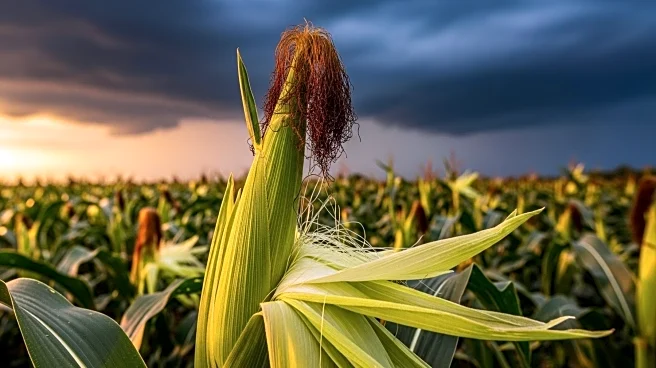What's Happening?
The U.S. Department of Agriculture (USDA) has increased its forecast for corn production in the 2025-2026 marketing year, projecting a record output of 16.814 billion bushels with a yield of 186.7 bushels per acre. This adjustment comes despite expectations for a decrease due to dry weather conditions in the Midwest. The USDA also raised its outlook for harvested acres to 90 million from 88.7 million in August. Soybean production is now projected at 4.301 billion bushels with a yield of 53.5 bushels per acre. Meanwhile, investors have taken a bearish stance on soybean futures, holding a net-short position of 13,382 futures contracts, according to the Commodity Futures Trading Commission (CFTC). Speculators are also net short in corn and wheat futures.
Why It's Important?
The USDA's revised production forecasts have significant implications for the agricultural sector and commodity markets. Higher production estimates could lead to lower prices, affecting farmers' revenues and market dynamics. The bearish positions held by investors indicate a lack of confidence in price increases, potentially impacting trading strategies and market volatility. These developments are crucial for stakeholders in the agriculture industry, including farmers, traders, and policymakers, as they navigate the economic landscape shaped by weather conditions and market expectations.
What's Next?
The agricultural sector will closely monitor weather patterns and market responses to the USDA's forecasts. Potential storms in parts of Iowa and Illinois could influence crop conditions and future production estimates. Additionally, the CFTC's weekly Commitment of Traders report will continue to provide insights into trader positions, guiding investment strategies and market predictions. Stakeholders may adjust their approaches based on evolving weather conditions and market trends.
Beyond the Headlines
The USDA's production forecasts and investor positions highlight the complex interplay between environmental factors and market dynamics. The agricultural industry must balance these elements to ensure sustainability and profitability. Long-term shifts in weather patterns and market behavior could drive changes in farming practices and investment strategies, emphasizing the need for adaptive measures in the face of uncertainty.












